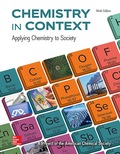
Interpretation:
Using bond energies present in Table
Concept Introduction:
Exothermic reaction: Exothermic reactions are those in which evolution of heat takes place during
Endothermic reaction: Endothermic reactions are those in which heat is absorbed during chemical reaction. In such type of reactions, external energy is needed.
Polymers are macromolecules which are formed a by number of repeating units called monomers.
Want to see the full answer?
Check out a sample textbook solution
Chapter 9 Solutions
EBK CHEMISTRY IN CONTEXT
- Use the web to research the amount of PVC polymer produced annually in the United States. What are the three most common uses of this polymer?arrow_forward9. List down the demanded properties of biodegradable polymer materials for biomedical applicationsarrow_forwardTwo biomolecules—starch and cellulose —illustrate how apparently minute differences in structure can result in vastly different properties ?arrow_forward
- The average bond enthalpy for C-His 413 kJ/mol. 413 kJ of energy is required to break a mole of CH into atoms: CH(g)→C(g) + H(g), AH=413 kJ Using this information, and your answer from Part A, calculate the enthalpy change of the reaction from Part B. That is, calculate the energy required to break only the carbon-carbon bonds in benzene. Express your answer to four significant figures and include the appropriate units. > View Available Hint(s) HA AHrxn = Value Units Submit Part D Complete previous part(s) Next > Provide Feedback 9:33 PM B. W Word Google .. Spotify .. 61°F 11/17/2021arrow_forwardDefine polymer chemistry.arrow_forwardDefine Polymers and Polymerization ?arrow_forward
- 7cd (JUST SIMPLY ANSWER THE QUESTION BELOW) 1. Why are olefins (alkanes) good monomers for polymerization reaction? 2. "Co-polymers" consist of two different monomers ("A" and "B") joined in an alternating fashion (ABABAB...). Block co-polymers also consist of two different monomers, but in this case, blocks of polymer containing only A units are joined to blocks of polymer containing only B units (AAAAABBBBB...). How block co-polymers are synthesized?arrow_forward1. Explain the term Photo-Polymerization and Elucidate the science behind Polymerization process.arrow_forwardDescribe two general approaches to toughening an amorphous polymer. Why do they work?arrow_forward
- In the addition polymer, Polyethylene how many monomer units are in the polyethylene polymer that has a molar mass of 1.4 x 101 g/mol? O 5 monomer units O 5000 monomer units O 500 monomer units O 50 monomer unitsarrow_forwardDefine polymerarrow_forward1. Nylon 6-6 is a condensation polymer. The last two experiments have pointed out that "condensation reactions are extremely common among a variety of organic functional groups." Pick two appropriate functional groups (your choice) and draw structures to show the condensation reaction between them. Identify the functional groups that are reacting, as well as the linkage formed by the condensation.arrow_forward
 Principles of Modern ChemistryChemistryISBN:9781305079113Author:David W. Oxtoby, H. Pat Gillis, Laurie J. ButlerPublisher:Cengage Learning
Principles of Modern ChemistryChemistryISBN:9781305079113Author:David W. Oxtoby, H. Pat Gillis, Laurie J. ButlerPublisher:Cengage Learning Chemistry: The Molecular ScienceChemistryISBN:9781285199047Author:John W. Moore, Conrad L. StanitskiPublisher:Cengage Learning
Chemistry: The Molecular ScienceChemistryISBN:9781285199047Author:John W. Moore, Conrad L. StanitskiPublisher:Cengage Learning Chemistry for Engineering StudentsChemistryISBN:9781285199023Author:Lawrence S. Brown, Tom HolmePublisher:Cengage Learning
Chemistry for Engineering StudentsChemistryISBN:9781285199023Author:Lawrence S. Brown, Tom HolmePublisher:Cengage Learning Chemistry for Engineering StudentsChemistryISBN:9781337398909Author:Lawrence S. Brown, Tom HolmePublisher:Cengage Learning
Chemistry for Engineering StudentsChemistryISBN:9781337398909Author:Lawrence S. Brown, Tom HolmePublisher:Cengage Learning




